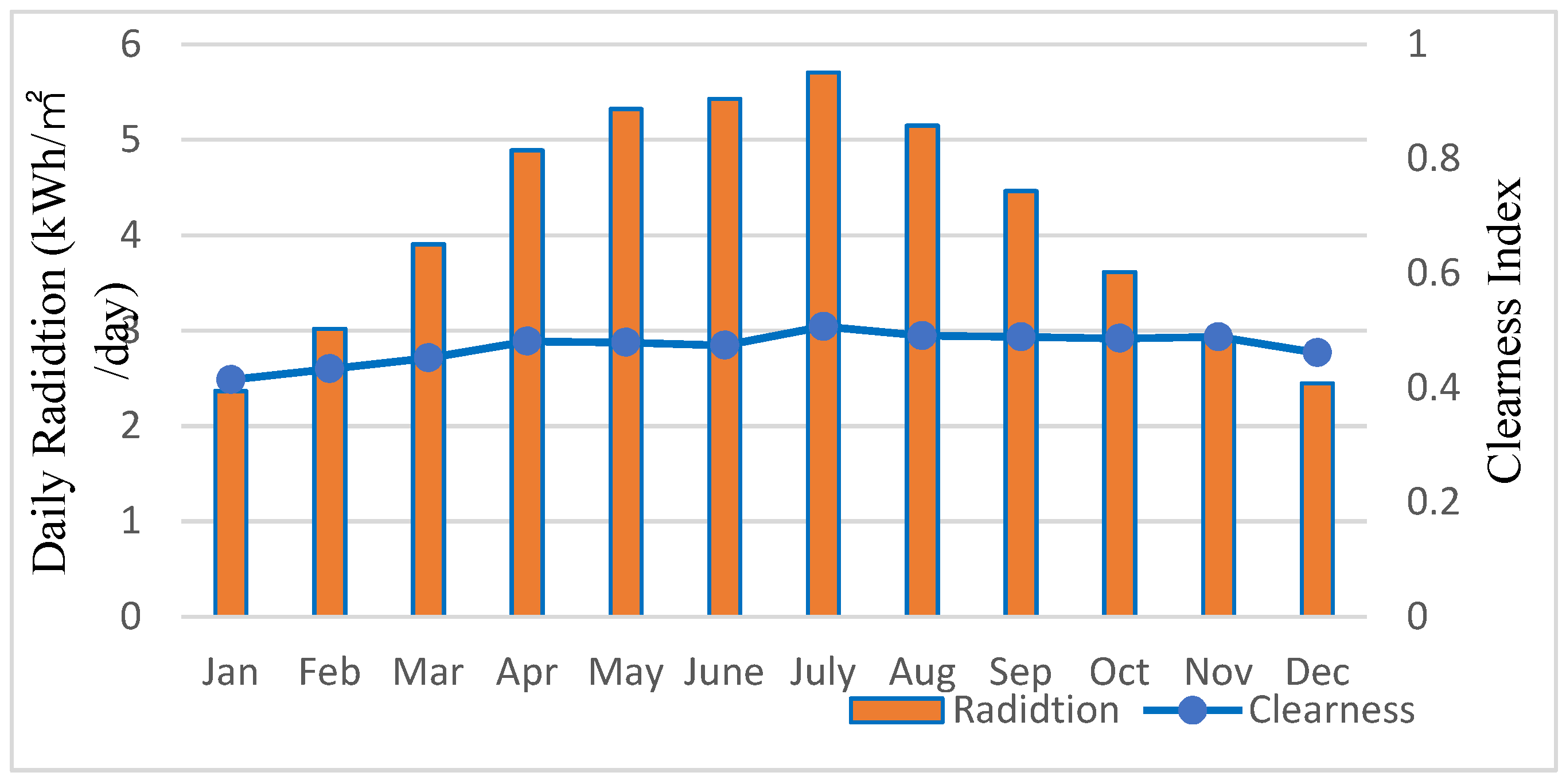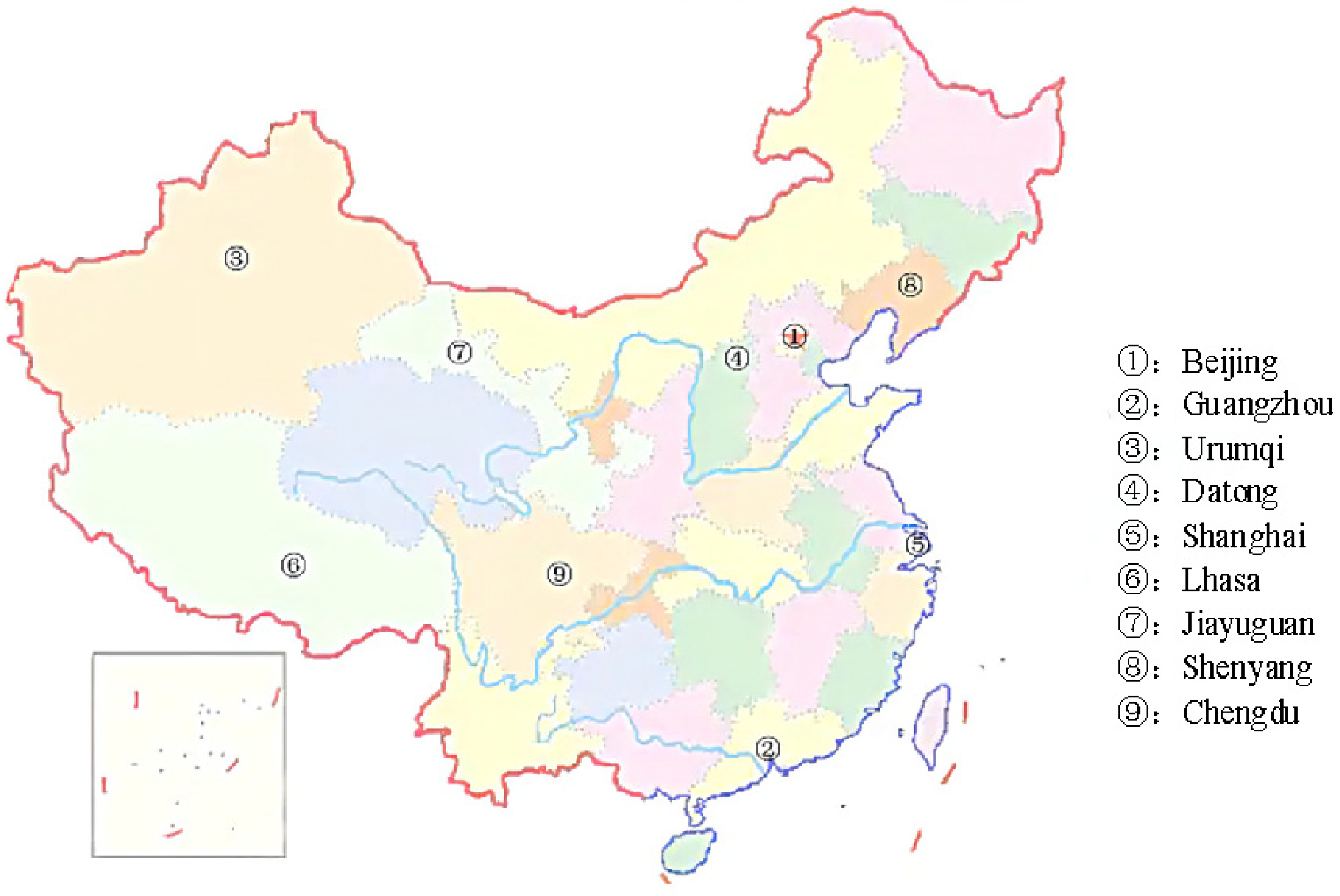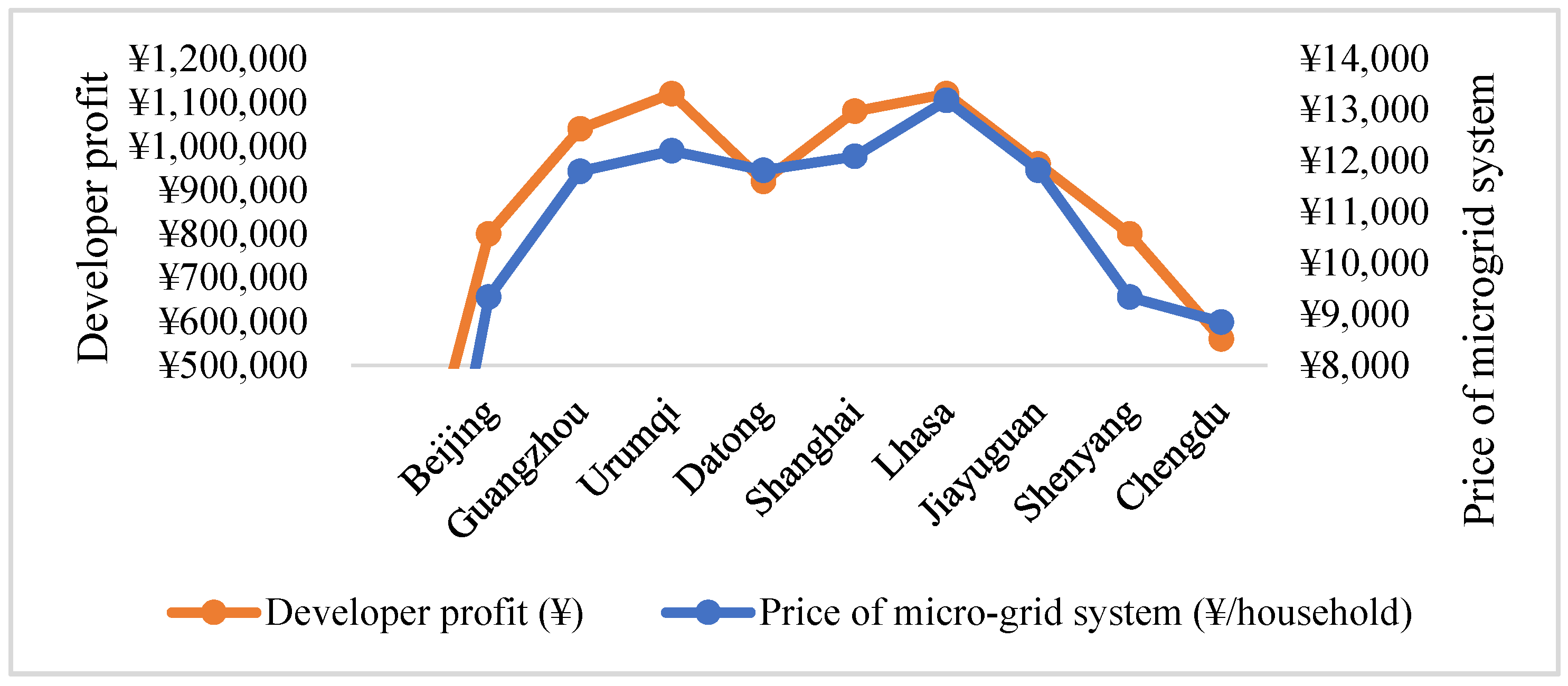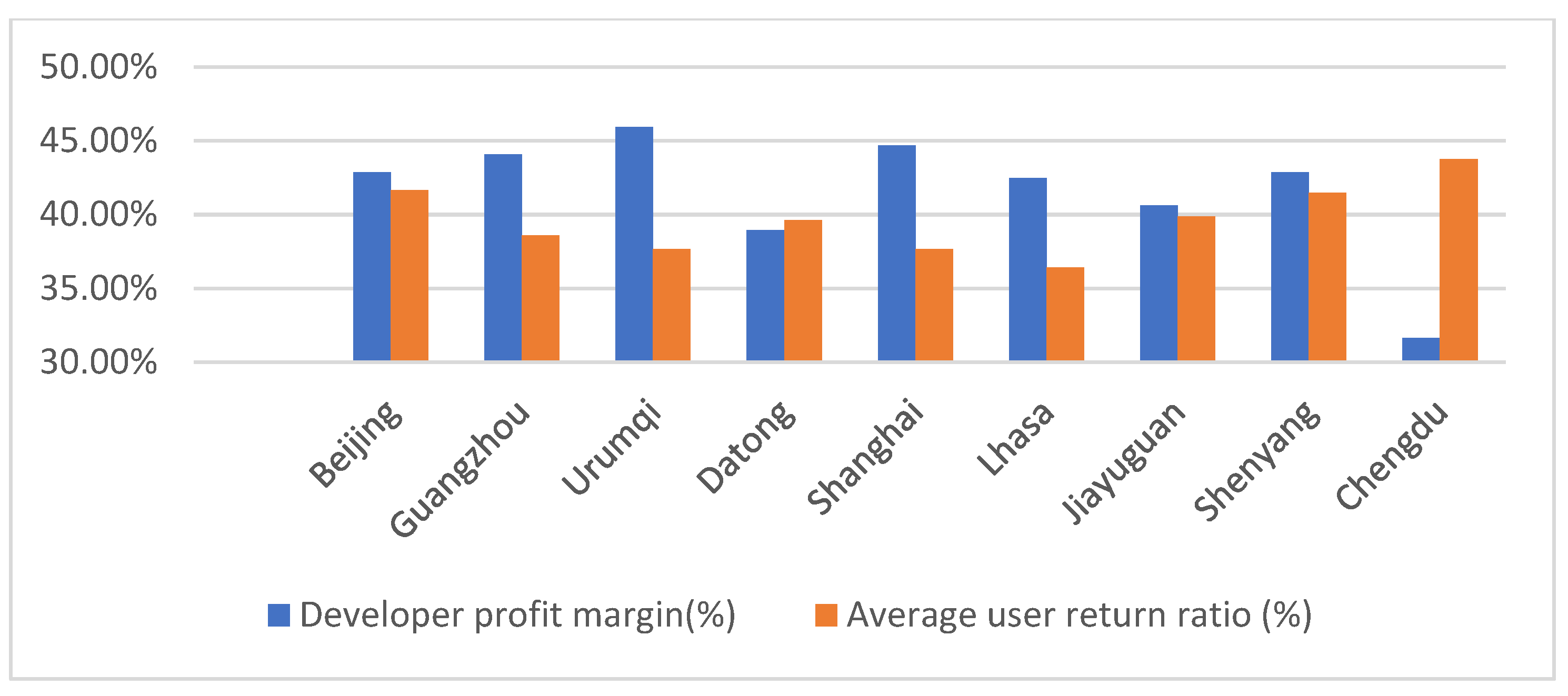A Game-Theoretic Approach to Design Solar Power Generation/Storage Microgrid System for the Community in China
Abstract
:1. Introduction
1.1. Background
1.2. Literature Review
1.3. Motivations and Main Contributions
- (1)
- This paper emphasizes the individual preferences and electricity consumption behaviors of different users. Then, the business mode and the operation strategy of the microgrid system are shown from two perspectives, the developer and community users. Therefore, it can enable all stakeholders to proactively support the construction of the microgrid project and the operation of low carbon communities.
- (2)
- A mathematical model is established for the game between the developer and community users. Particularly, the detailed measurements of community users are expressed with formulas for the first time, including the pricing module, demand response module, and electricity expenditure module.
- (3)
- Different scenarios with real data are analyzed and compared in numerical experiments. The conclusions are not only useful for the developers and residential users in different locations, but also can provide support for policy makers in the government when promoting the development of the PV industry.
1.4. Paper Structure
2. Problem Description
2.1. Problem Formulation
2.2. Game between Two Sides
3. Mathematical Model
3.1. The Upper-Level Optimization Model
3.2. The Lower-Level Optimization Model
3.2.1. PV Power Generation Pricing Sub-Module
- Principle I: PV electricity prices at any given time should be lower than the benchmark electricity prices of the local public grid (the price of household electricity ).
- Principle II: The PV electricity tariff in any time period should be lower than the local PV feed-in tariff .
- Principle III: The PV electricity price is lower during the time period when more solar power is generated.
3.2.2. Demand Response Sub-Module
3.2.3. Residential Users’ Electricity Expenditure Sub-Module
4. Numerical Analysis
4.1. Scenario I—Residential Community in Shanghai
4.2. Scenario II—Residential Community in Shanghai with PV Subsidies in Consideration
4.3. Scenario III—Independent Operation of Each User
4.4. Scenario IV—Residential Community in Different Regions
4.5. Scenario V—Comparison between Two Common Patterns
5. Discussions
- (1)
- Under the current market data, including the price of solar power components and the electricity price of residents drawing from the main grid, the business mode is only applicable in some cities with a good amount of sunshine. Shanghai is a representative city with large number of communities, advanced perception of sustainable development, and good sunshine in China. Therefore, it is easier to promote this mode in Shanghai.
- (2)
- Under the market dominated by the system developer, the PV subsidy supported by government cannot easily reach its expected result. Accordingly, the government should introduce a series of related policies along with the subsidy policy, and strive to change the game structure of both sides in the market so as to enable the residents to truly benefit from the subsidy.
- (3)
- Although the government prefers to execute the build-hold pattern to avoid disputes after the transaction, the system developer is less motivated for this pattern due to the low return on investment. Most Chinese developers currently favor accelerated development cycles, in which higher turnover models are more popular and capital chains are less vulnerable to breakage. Therefore, more pointed policies need to be made in order to promote the build-hold pattern.
- (4)
- As for the operations management method of the microgrid system, it can be found that the benefit of centralized management is much better than that of independent management. It should be noticed that the advocated centralized management brings a lot of pressure to the community resident committee, who must monitor the whole system and manage the joint account of all residents.
- (5)
- For residents, households with higher electricity demand gain more benefit through participating in the microgrid system. This phenomenon is inevitable although the fairness has already been considered in the model. Nonetheless, in the developer-dominated microgrid project, the majority of the benefits from installing the microgrid are gained by the developer instead of the residential users.
6. Conclusions
Author Contributions
Funding
Data Availability Statement
Conflicts of Interest
Appendix A
| Parameter List | Parameter Definition | Value | Data Source |
|---|---|---|---|
| Sunlight intensity for each hour of the year | / | NREL (National Renewable Energy Lab) | |
| Sunlight intensity under standard conditions | 1 kW/m2 | Report from China Photovoltaic Industry Association [35] | |
| Enumeration range of the installed scale of PV system per household | 0–4 kWp | http://www.meonsolar.com/ (accessed on 1 December 2021) | |
| Average household population in Shanghai area | 2.32 persons/household | Shanghai Seventh National Population Census Main Data Bulletin | |
| Average annual electricity consumption per resident | 1214.655 kWh/person | Statistical Bulletin of National Economic and Social Development of Shanghai in 2020 |
| Components | Type | Specification | Price |
|---|---|---|---|
| Inverter | PSN-4000W | 4 kW | CNY 590/unit 1 |
| AC distribution cabinet | PZ30-12 | / | CNY 127/unit |
| Storage batteries | Lead-acid colloid | 200 Ah | CNY 1099/unit |
| PV array | Mono-crystalline silicon | 200 W/unit | CNY 425/unit |
| PV mount | Aluminum alloy | Withstand two pieces of 50–200 W electric plate | CNY 328/unit |
| PV controller | 12V/24V | 12V60A | CNY 349/unit |
| Accessories | Specification | Price |
|---|---|---|
| 4P red & black 5 m line | 5 m/stem | CNY 78/stem |
| Y-type 3-way connection cable | MC4 | CNY 32/stem |
| Battery connection cable | 0.4 m/stem | CNY 32/stem |
| Controller connection cable | 1.5 m/stem | CNY 39/stem |
References
- General Institute of Hydro-power Planning and Design of China. China Renewable Energy Development Report 2020. Available online: http://16j.powerchina.cn/art/2021/6/30/art_5173_1163554.html (accessed on 20 October 2021).
- Luo, X.; Liu, J. Economic analysis of residential distributed solar photovoltaic. Front. Eng. Manag. 2015, 2, 125–130. [Google Scholar] [CrossRef]
- Yin, H.X.; Liu, Z.Y. Research on the Function Performance Deviations of China’s Urban Community Residents Committees and Its Countermeasures. In Proceedings of the 11th International Conference on Public Administration, Bandung, Indonesia, 9–11 December 2015; Volume 2, pp. 311–316. [Google Scholar]
- Manshadi, S.D.; Khodayar, M.E. A hierarchical electricity market structure for the smart grid paradigm. In Proceedings of the IEEE Transactions on Smart Grid, Boston, MA, USA, 17–21 July 2016; IEEE: Manhattan, NY, USA, 2016; Volume 7, pp. 1866–1875. [Google Scholar]
- Fang, X.H.; Wang, J.K.; Song, G.R.; Han, Y.H.; Zhao, Q.; Cao, Z. Multi-agent reinforcement learning approach for residential microgrid energy scheduling. Energies 2020, 13, 123. [Google Scholar] [CrossRef]
- Wang, D.; Qiu, J.; Reedman, L.; Meng, K.; Lai, L.L. Two-stage energy management for networked microgrids with high renewable penetration. Appl. Energy 2018, 226, 39–48. [Google Scholar] [CrossRef]
- Huang, Y.; Yang, L.; Liu, S.; Wang, G. Cooperation between Two Micro-Grids Considering Power Exchange: An Optimal Sizing Approach Based on Collaborative Operation. Sustainability 2018, 10, 4198. [Google Scholar] [CrossRef]
- Ju, L.W.; Huang, L.I.; Lin, H.L.; Tan, Z.F. An interactive dispatching strategy for micro energy grids considering multi-energy flexible conversion based on the three-level optimization perspective. Sustain. Cities Soc. 2021, 64, 102504. [Google Scholar] [CrossRef]
- Mohammadi, M.; Nafar, M.; Nasiraghdam, H.; Azadbakht, B. Micro-grid optimization as grid-connected in pool-based power market under pay-as-bid and uniform pricing. Int. Rev. Electr. Eng. 2012, 7, 4236–4248. [Google Scholar]
- Akbary, P.; Ghiasi, M.; Pourkheranjani, M.R.R.; Alipour, H.; Ghadimi, N. Extracting Appropriate Nodal Marginal Prices for All Types of Committed Reserve. Comput. Econ. 2019, 53, 1–26. [Google Scholar] [CrossRef]
- Ghadimi, N.; Akbarimajd, A.; Shayeghi, H.; Abedinia, O. Two stage forecast engine with feature selection technique and improved meta-heuristic algorithm for electricity load forecasting. Energy 2018, 161, 130–142. [Google Scholar] [CrossRef]
- Wei, F.; Jing, Z.X.; Wu, P.Z.; Wu, Q.H. A Stackelberg game approach for multiple energies trading in integrated energy systems. Appl. Energy 2017, 200, 315–329. [Google Scholar] [CrossRef]
- Luo, X.; Liu, Y.; Liu, J.; Liu, X. Energy scheduling for a three-level integrated energy system based on energy hub models: A hierarchical Stackelberg game approach. Sustain. Cities Soc. 2020, 52, 101814. [Google Scholar] [CrossRef]
- Zhang, X.S.; Bao, T.; Yu, T.; Yang, B.; Han, C.J. Deep transfer Q-learning with virtual leader-follower for supply-demand Stackelberg game of smart grid. Energy 2017, 133, 348–365. [Google Scholar] [CrossRef]
- Xu, Z.H.; Zhang, P.; Wang, Q.P. The key technology research on transient stability control of micro-grid. In Proceedings of the 2012 China International Conference on Electricity Distribution, Shanghai, China, 14 September 2012. [Google Scholar]
- Zhao, B.; Zhang, X.; Chen, J.; Wang, C.S.; Guo, L. Operation optimization of standalone microgrids considering lifetime characteristics of battery energy storage system. In IEEE Transactions on Sustainable Energy; IEEE: Manhattan, NY, USA, 2013; Volume 4, pp. 934–943. [Google Scholar]
- Chen, Y.; Deng, C.; Yao, W.; Liang, N.; Xia, P.; Cao, P.; Dong, Y.; Zhang, Y.-A.; Liu, Z.; Li, D.; et al. Impacts of stochastic forecast errors of renewable energy generation and load demands on micro grid operation. Renew. Energy 2019, 133, 442–461. [Google Scholar] [CrossRef]
- Grover-Silva, E.; Heleno, M.; Mashavekh, S.; Cardoso, G.; Girard, R.; Kariniotakis, G. A stochastic optimal power flow for scheduling flexible resources in microgrids operation. Appl. Energy 2018, 229, 201–208. [Google Scholar] [CrossRef]
- Wang, Y.; Huang, Y.; Wang, Y.; Li, F.; Zhang, Y.; Tian, C. Operation Optimization in a Smart Micro-Grid in the Presence of Distributed Generation and Demand Response. Sustainability 2018, 10, 847. [Google Scholar] [CrossRef]
- Tushar, M.H.K.; Assi, C.; Maier, M. Distributed Real-Time Electricity Allocation Mechanism for Large Residential Microgrid. IEEE Trans. Smart Grid 2015, 6, 1353–1363. [Google Scholar]
- Zamani, A.G.; Zakariazadeh, A.; Jadid, S. Day-ahead resource scheduling of a renewable energy based virtual power plant. Appl. Energy 2016, 169, 324–340. [Google Scholar] [CrossRef]
- Wang, S.D.; Mao, Y.R.; Jia, G.Y.; Song, H.; Qiu, J.; Ding, T. Optimal configuration of optical storage microgrid under demand-side response based on cooperative game. J. Phys. Conf. Ser. 2019, 1187, 022065. [Google Scholar] [CrossRef]
- Kalavani, F.; Mohammadi-Ivatloo, B.; Karimi, A.; Kalavani, F. Stochastic optimal sizing of integrated cryogenic energy storage and air liquefaction unit in microgrid. Renew. Energy 2019, 136, 15–22. [Google Scholar] [CrossRef]
- Zhao, M.; Shen, C.; Li, S.X. Coalitional game theoretic method to study multi-microgrids cooperation condition considering outage risk. Control Theory Appl. 2018, 35, 688–698. [Google Scholar]
- Mashavekh, S.; Stadler, M.; Cardoso, G.; Heleno, M. A mixed integer linear programming approach for optimal DER portfolio, sizing, and placement in multi-energy microgrids. Appl. Energy 2017, 187, 154–168. [Google Scholar] [CrossRef]
- Long, Y.; Wang, Y.; Pan, C. Incentive Mechanism of Micro-grid Project Development. Sustainability 2018, 10, 163. [Google Scholar] [CrossRef]
- Dehghani, M.; Ghiasi, M.; Niknam, T.; Kavousi-Fard, A.; Shasadeghi, M.; Ghadimi, N.; Taghizadeh-Hesary, F. Blockchain-Based Securing of Data Exchange in a Power Transmission System Considering Congestion Management and Social Welfare. Sustainability 2021, 13, 90. [Google Scholar] [CrossRef]
- Zhang, Y.; Zhang, T.; Wang, R.; Liu, Y.J.; Guo, B. Optimal operation of a smart residential micro grid based on model predictive control by considering uncertainties and storage impacts. Sol. Energy 2015, 122, 1052–1065. [Google Scholar] [CrossRef]
- He, Y.D.; Zhou, Y.K.; Yuan, J.; Liu, Z.X.; Wang, Z.; Zhang, G.Q. Transformation towards a carbon-neutral residential community with hydrogen economy and advanced energy management strategies. Energy Convers. Manag. 2021, 249, 114834. [Google Scholar] [CrossRef]
- Wang, J.; Li, P.; Fang, K.; Zhou, Y. Robust Optimization for Household Load Scheduling with Uncertain Parameters. Appl. Sci. 2018, 8, 575. [Google Scholar] [CrossRef]
- Samadi, P.; Mohsenian-Rad, H.; Wong, V.W.; Schober, R. Utilizing renewable energy resources by adopting DSM techniques and storage facilities. In Proceedings of the IEEE International Conference on Communications, Sydney, Australia, 14 October 2014; IEEE: Manhattan, NY, USA, 2014. [Google Scholar]
- Alilou, M.; Tousi, B.; Shayeghi, H. Home energy management in a residential smart micro grid under stochastic penetration of solar panels and electric vehicles. Sol. Energy 2020, 212, 6–18. [Google Scholar] [CrossRef]
- Olsen, D.J.; Sarker, M.R.; Ortega-Vazquez, M.A. Optimal penetration of home energy management systems in distribution networks considering transformer aging. IEEE Trans. Smart Grid 2018, 9, 3330–3340. [Google Scholar] [CrossRef]
- Sarker, M.R.; Olsen, D.J.; Ortega-Vazquez, M.A. Co-optimization of distribution transformer aging and energy arbitrage using electric vehicles. IEEE Trans. Smart Grid 2017, 8, 2712–2722. [Google Scholar] [CrossRef]
- Ma, Y.L.; Chen, X.; Wang, L.M.; Yang, J.L. Investigation of Smart Home Energy Management System for Demand Response Application. Front. Energy Res. 2021, 9, 772027. [Google Scholar] [CrossRef]
- Wang, C.; Zhou, Y.; Wu, J.; Wang, J.; Zhang, Y.; Wang, D. Robust-Index Method for Household Load Scheduling Considering Uncertainties of Customer Behavior. IEEE Trans. Smart Grid 2015, 6, 1806–1818. [Google Scholar] [CrossRef]
- Khodaei, H.; Hajiali, M.; Darvishan, A.; Sepehr, M.; Ghadimi, N. Fuzzy-based heat and power hub models for cost-emission operation of an industrial consumer using compromise programming. Appl. Therm. Eng. 2018, 137, 395–405. [Google Scholar] [CrossRef]
- China Photovoltaic Industry Association. China Photovoltaic Industry Development Road Map. Available online: http://chinapv.org.cn/road_map/927.html (accessed on 20 October 2021).
- China Photovoltaic Industry Association. China Photovoltaic Industry Annual Report. Available online: http://chinapv.org.cn/annual_report/821.html (accessed on 20 October 2021).
- Jd.com. MPPTSUNSWM150W. Available online: https://item.jd.com/10030139729713.html#product-detail (accessed on 20 December 2021).
- Jd.com. MPPTSUN Solar Colloidal Lead-Acid Battery. Available online: https://item.jd.com/10035298774674.html#crumb-wrap (accessed on 20 December 2021).
- National Development and Reform Commission of the People’s Republic of China. Notice of the National Development and Reform Commission on Matters Related to the New Energy Feed-In Tariff Policy in 2021. Available online: https://zfxxgk.ndrc.gov.cn/web/iteminfo.jsp?id=18168 (accessed on 20 November 2021).
- State Grid Shanghai Electric Power Company. Fee Standard of Operating Service. Available online: http://www.sh.sgcc.com.cn/html/main/col706/2021-04/27/20210427145057938221979_1.html (accessed on 20 November 2021).
- Jordan, D.C.; Kurtz, S.R.; Vansant, K.; Newmiller, J. Compendium of photovoltaic degradation rates. Prog. Photovolt. Res. Appl. 2016, 24, 978–989. [Google Scholar] [CrossRef]
- Li, Z.S. Photovoltaic Distributed Generation Systems: Design, Installation, Operation and Maintenance, 2nd ed.; China Machine Press: Beijing, China, 2019; pp. 149–151. [Google Scholar]
- Jd.com. MPPTSUN Solar Inverter. Available online: https://item.jd.com/10028088010512.html#crumb-wrap (accessed on 20 December 2021).
- Baidu Library. Calculation of the Annual Electricity Consumption of Shanghai Municipal Residents. Available online: https://wenku.baidu.com/view/be2b3d92dd88d0d233d46ac3.html (accessed on 20 December 2021).
- Shanghai Bureau of Statistics. The Shanghai Statistical Yearbook. Available online: http://tjj.sh.gov.cn/tjnj/20210303/2abf188275224739bd5bce9bf128aca8.html (accessed on 20 December 2021).
- Shanghai Municipal Development & Reform Commission. Shanghai Renewable Energy and New Energy Development Special Funds Support Measures (2020 Edition). Available online: https://fgw.sh.gov.cn/fgw_gfxwj/20211123/190e765b92e04236920f3d0e17785322.html (accessed on 20 January 2022).







| Parameter List | Parameter Definition | Value | Data Source |
|---|---|---|---|
| Total number of users purchasing the house | 200 households | / | |
| PV system unit O&M cost | 0.054 CNY/W/year | Report from China Photovoltaic Industry Association [38] | |
| Unit price of battery | 457.92 CNY/kWh | Report from China Photovoltaic Industry Association [39] | |
| PV accessories determined by the PV system size | 2.945 CNY/W | Calculated from component prices | |
| PV accessories determined by user number | 1183 CNY/family | Calculated from component prices | |
| Cost of connecting wires between solar panels | 32 CNY/bar | Reference component prices | |
| Power of each solar electric panel | 200 w/piece | Online Business Data [40] | |
| Life span of colloidal battery | 8 year | Online Business Data [41] | |
| PV power generation guide feed-in tariff | 0.4146 CNY/kWh | Related National Policies [42] | |
| Peak hour tariffs for the public grid | 0.617 CNY/kWh | Residential electricity tariff in Shanghai [43] | |
| Valley hour tariffs for the public grid | 0.307 CNY/kWh | Residential electricity tariff in Shanghai [43] | |
| Attenuation coefficient of PV module power generation | 0.85% | The Current Literature [44] | |
| PV Derating Factor | 0.9 | Related Design Manuals [45] | |
| Inverter efficiency | 90% | Online Business Data [46] | |
| Average annual discount rate for the next 25 years | 0.05 | Refer to current Bank of China discount rate | |
| Average daily electricity consumption per user for various loads | / | Online social survey [47] & Shanghai Statistical Yearbook 2020 [48] |
| Specific Configuration | Numerical Value |
|---|---|
| Price of the microgrid system (CNY/household) | 12,088.59 |
| Developer’s profit (CNY) | 1,080,000 |
| Developer profit margin | 44.67% |
| PV system scale (kWp) 1 | 1.4 |
| Battery installation scale (Ah) | 216.67 |
| Average revenue per user (CNY) | 4552.33 |
| Average user return ratio | 37.66% |
| User Types | Average Revenue of the User (CNY) | Average User Yield |
|---|---|---|
| User group with 2 family members | 1245.86 | 10.31% |
| User group with 3 family members | 4781.07 | 39.55% |
| User group with 4 family members | 7676.68 | 63.50% |
| User Types | Average Revenue of the User (CNY) | Average User Yield |
|---|---|---|
| User groups with a power saving factor between 0.8 and 0.9 | 3592.16 | 29.72% |
| User groups with a power saving factor between 0.9 and 1.0 | 3916.00 | 32.39% |
| User groups with a power saving factor between 1.0 and 1.1 | 4948.32 | 40.93% |
| User groups with a power saving factor between 1.1 and 1.2 | 6303.41 | 52.14% |
| Specific Configuration | Experimental Results with Subsidized Scenarios | Experimental Results without Subsidized Scenarios |
|---|---|---|
| Price of microgrid system (CNY/household) | 17,280.10 | 12,088.59 |
| Developer’s profit (CNY) | 1,760,000 | 1,080,000 |
| Developer profit margin | 50.90% | 44.67% |
| PV system scale (kWp) | 1.8 | 1.4 |
| Battery installation scale (Ah) | 316.67 | 216.67 |
| Average revenue per user (CNY) | 5052.16 | 4552.33 |
| Average user return ratio | 29.24% | 37.66% |
| Specific Configuration | Experimental Results with Subsidized Scenarios | Experimental Results without Subsidized Scenarios |
|---|---|---|
| Price of microgrid system (CNY/household) | 10,171.84 | 12,088.59 |
| Developer’s profit (CNY) | 1,000,000 | 1,080,000 |
| Developer profit margin | 49.16% | 44.67% |
| PV system scale (kWp) | 1.0 | 1.4 |
| Battery installation scale (Ah) | 166.67 | 216.67 |
| Average revenue per user (CNY) | 3940.98 | 4552.33 |
| Average user return ratio | 38.74% | 37.66% |
| Specific Configuration | Price of System (CNY/Household) | Developer Profit (CNY) | Developer Profit Margin | PV System Scale (kWp) | Battery Installation Scale (Ah) | Average Revenue per User (CNY) | Average User Return Ratio |
|---|---|---|---|---|---|---|---|
| Beijing | 9334.92 | 800,000 | 42.85% | 1.2 | 83.33 | 3889.27 | 41.66% |
| Guangzhou | 11,797.01 | 1,040,000 | 44.08% | 1.4 | 200.00 | 4552.72 | 38.59% |
| Urumqi | 12,197.01 | 1,120,000 | 45.91% | 1.4 | 200.00 | 4593.82 | 37.66% |
| Datong | 11,818.01 | 920,000 | 38.92% | 1.6 | 200.00 | 4681.93 | 39.62% |
| Shanghai | 12,088.59 | 1,080,000 | 44.67% | 1.4 | 216.67 | 4552.33 | 37.66% |
| Lhasa | 13,184.34 | 1,120,000 | 42.47% | 1.6 | 266.67 | 4801.54 | 36.42% |
| Jiayuguan | 11,818.01 | 960,000 | 40.62% | 1.6 | 200.00 | 4711.11 | 39.86% |
| Shenyang | 9334.92 | 800,000 | 42.85% | 1.2 | 83.33 | 3872.35 | 41.48% |
| Chengdu | 8847.50 | 560,000 | 31.65% | 1.4 | 100.00 | 3872.35 | 43.77% |
| Specific Configuration | Build-Hold Pattern | Build-Sell Pattern |
|---|---|---|
| Developer’s profit (CNY) | 200,299.80 | 1,080,000 |
| Developer profit margin | 25.03% | 44.67% |
| PV system scale (kWp) | 0.8 | 1.4 |
| Battery installation scale (Ah) | 66.67 | 216.67 |
| 0.00 | 0.01 |
Publisher’s Note: MDPI stays neutral with regard to jurisdictional claims in published maps and institutional affiliations. |
© 2022 by the authors. Licensee MDPI, Basel, Switzerland. This article is an open access article distributed under the terms and conditions of the Creative Commons Attribution (CC BY) license (https://creativecommons.org/licenses/by/4.0/).
Share and Cite
Zhou, X.; Shou, J.; Cui, W. A Game-Theoretic Approach to Design Solar Power Generation/Storage Microgrid System for the Community in China. Sustainability 2022, 14, 10021. https://doi.org/10.3390/su141610021
Zhou X, Shou J, Cui W. A Game-Theoretic Approach to Design Solar Power Generation/Storage Microgrid System for the Community in China. Sustainability. 2022; 14(16):10021. https://doi.org/10.3390/su141610021
Chicago/Turabian StyleZhou, Xue, Jianan Shou, and Weiwei Cui. 2022. "A Game-Theoretic Approach to Design Solar Power Generation/Storage Microgrid System for the Community in China" Sustainability 14, no. 16: 10021. https://doi.org/10.3390/su141610021
APA StyleZhou, X., Shou, J., & Cui, W. (2022). A Game-Theoretic Approach to Design Solar Power Generation/Storage Microgrid System for the Community in China. Sustainability, 14(16), 10021. https://doi.org/10.3390/su141610021





